|
[ Back ] [ Home ] [ Up ] [ Next ]
|
Cursor over pictures to
display caption; click to enlarge then close out of that window.
Slide shows have
captions; you may need to "Allow Blocked Content" if slide show does not
load. |
|
GUATEMALA
Part 7:
|
|
Click
here to jump back to
Guatemala Part 6 on
Pictures/Journal - page 25. |
|
MONTERRICO
 In
mid-November 2007, we travel from the Rio Dulce to Guatemala City for
shopping, then on to Antigua for another "fix" (we love Antigua).
From there a couple-hour trip, on probably the best highway in Guatemala,
takes us to Guatemala's southern Pacific coast and the coastal village of
Monterrico. Here a mighty surf crashes onto a very long, wide black volcanic
sand beach. Guatemalans like Monterrico as a low-key, weekend
getaway. It is also known for its turtle reserves and at the right time
of the year the public can release newly hatched turtles to the sea - which
was our primary purpose for going. We made the trip with no
expectations, and our expectations were exceeded. (See box below for
Trip Recommendations.) In
mid-November 2007, we travel from the Rio Dulce to Guatemala City for
shopping, then on to Antigua for another "fix" (we love Antigua).
From there a couple-hour trip, on probably the best highway in Guatemala,
takes us to Guatemala's southern Pacific coast and the coastal village of
Monterrico. Here a mighty surf crashes onto a very long, wide black volcanic
sand beach. Guatemalans like Monterrico as a low-key, weekend
getaway. It is also known for its turtle reserves and at the right time
of the year the public can release newly hatched turtles to the sea - which
was our primary purpose for going. We made the trip with no
expectations, and our expectations were exceeded. (See box below for
Trip Recommendations.)
|
LOOFAH
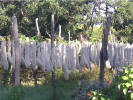 This
is loofah (those natural sponge-like things used for bathing)
country. This wet-island environment is ideal growing
conditions for this cash crop. Loofahs grow on vines on
trellises as long, green "pods", up to 3 feet long. There is
one crop a year, then the vine dies, it is cut down and a new crop
of vines planted the next year. 20,000 - 25,000 loofahs are
harvested a year, and they are sold for Q10 ($1.30) each. This
is loofah (those natural sponge-like things used for bathing)
country. This wet-island environment is ideal growing
conditions for this cash crop. Loofahs grow on vines on
trellises as long, green "pods", up to 3 feet long. There is
one crop a year, then the vine dies, it is cut down and a new crop
of vines planted the next year. 20,000 - 25,000 loofahs are
harvested a year, and they are sold for Q10 ($1.30) each.
|
|
A main draw for
tourist, like ourselves, is the Tortugario Monterrico, a turtle hatchery.
Leatherback and olive ridley turtles nest on this beach from June to
November. Their nests are moved to a secured hatchery to protect them from
predators and poachers. From September to January - when the babies
are hatching - a ritual takes place every Saturday evening on the
beach in front of the Tortugario: Sunset turtle
 races.
For a small donation, you get your own newly hatched turtle (for us it was
leatherback), and at the "start" sound, you put your turtle on the
start line and watch him (or her) scramble down the beach to the sea.
The "owner" of the first turtle to make it gets a free dinner. But
there is a catch. I was worried about human-handling of the turtles
and how it might be bad for them, but that's nothing when you see the big
surf the poor things have to battle in order to make it out. Most
turtles lose ground as a big wave carries them backward. Then they
regain their footing and sense of direction and try
again, get thrown back again, and again, and finally they all make it out to
sea. We were there for the crowded Saturday night event; but they also
release every night (without the contest) so we returned the next night to
release more turtles. races.
For a small donation, you get your own newly hatched turtle (for us it was
leatherback), and at the "start" sound, you put your turtle on the
start line and watch him (or her) scramble down the beach to the sea.
The "owner" of the first turtle to make it gets a free dinner. But
there is a catch. I was worried about human-handling of the turtles
and how it might be bad for them, but that's nothing when you see the big
surf the poor things have to battle in order to make it out. Most
turtles lose ground as a big wave carries them backward. Then they
regain their footing and sense of direction and try
again, get thrown back again, and again, and finally they all make it out to
sea. We were there for the crowded Saturday night event; but they also
release every night (without the contest) so we returned the next night to
release more turtles.
 This
is a rather laid-back place. Besides bumming on the beach and doing
the turtle thing, there's a few eco-things to see. We took an early
morning paddled (no motors) boat trip around the canals, swamps, lagoons and
mangroves, which was very serene and photogenic. This
is a rather laid-back place. Besides bumming on the beach and doing
the turtle thing, there's a few eco-things to see. We took an early
morning paddled (no motors) boat trip around the canals, swamps, lagoons and
mangroves, which was very serene and photogenic.
 Some
things have changed since the Lonely Planet Guide (ed. 2004) was published -
some for the better and some for the worse. For the better, we saw
virtually NO trash on the beach, on our mangrove boat trip or even walking
around the neighborhood. For the worse, or at least controversial, is
the construction of a brand new, private bridge from the mainland to
the island. Prior to the bridge, pedestrian and vehicular traffic had to
take lanchas and ferries across the canal to the island. Now with the
bridge, all the locally-operated lanchas and ferries are being put out of
business. Going over, our van driver paid the $6.50 toll; coming back
a different van driver refused to use the bridge (support your local
economy) and so we braved the ferry-barge ($3.25). Some
things have changed since the Lonely Planet Guide (ed. 2004) was published -
some for the better and some for the worse. For the better, we saw
virtually NO trash on the beach, on our mangrove boat trip or even walking
around the neighborhood. For the worse, or at least controversial, is
the construction of a brand new, private bridge from the mainland to
the island. Prior to the bridge, pedestrian and vehicular traffic had to
take lanchas and ferries across the canal to the island. Now with the
bridge, all the locally-operated lanchas and ferries are being put out of
business. Going over, our van driver paid the $6.50 toll; coming back
a different van driver refused to use the bridge (support your local
economy) and so we braved the ferry-barge ($3.25).
|
MONTERRICO
TRIP RECOMMENDATIONS
 We
stayed at, and recommend, Hotel Pez de Oro (tel. ? 7204-5249 or
5204-5249 ?) and had one of their best rooms (#13, Q390/$52, although
all rooms cost the same, I think), a comfortable, thatched-roof "cabina"
upstairs with a private ocean-view balcony with hammock, 2 queen beds
with mosquito netting, ceiling fan, no hot water, We
stayed at, and recommend, Hotel Pez de Oro (tel. ? 7204-5249 or
5204-5249 ?) and had one of their best rooms (#13, Q390/$52, although
all rooms cost the same, I think), a comfortable, thatched-roof "cabina"
upstairs with a private ocean-view balcony with hammock, 2 queen beds
with mosquito netting, ceiling fan, no hot water,
 good
natural breeze and the sound of the crashing surf. This is the
most "upscale" place in Monterrico that we found, only surpassed by
the brand new Dos Mundos. Dos Mundos ($95+, includes breakfast)
is a "resort" used by non-English speaking tourists (i.e., wealthy
Guatemalans), with a black sand beach but since they don't want to get
their feet sandy there is an infinity pool at the beach edge. We
enjoyed a good lunch (around the pool) and dinner there - probably the
best food you're going to find in the area. good
natural breeze and the sound of the crashing surf. This is the
most "upscale" place in Monterrico that we found, only surpassed by
the brand new Dos Mundos. Dos Mundos ($95+, includes breakfast)
is a "resort" used by non-English speaking tourists (i.e., wealthy
Guatemalans), with a black sand beach but since they don't want to get
their feet sandy there is an infinity pool at the beach edge. We
enjoyed a good lunch (around the pool) and dinner there - probably the
best food you're going to find in the area.
We originally
made reservations (then cancelled upon inspection) at Mangles based on
Lonely Planet (ed. 2004), which we found to be VERY much out of date.
Mangles might be ok for a backpacker (suppose the description "good
value" should have tipped us off!) - we describe as "scuzzy" at best.
All other lodging options appeared questionable and similar to
Mangles.
For
transportation, we used Atitours van service (door-to-door service).
We liked hanging out at Johnny's (backpacker place) on the beach for
afternoon/sunset cocktails. NOTE: The black sand beaches get
VERY HOT so be sure to take suitable beach shoes. (Nov.
2008) |
[
Top of page ] |
| |
DAD'S VISIT
TO GUATEMALA
 Late November 2007, Deborah's Dad, Chuck,
came to visit us in Guatemala for 2 weeks. We met him in Guatemala
City and enjoyed our first meal together at a very fine restaurant
specializing in authentic Guatemalan cuisine and atmosphere, the men-only wait
staff wearing his own pueblo's
traditional dress. The next day we headed off to lovely Antigua, a place we knew he
would love. We spent a wonderful
Thanksgiving there, enjoying a
traditional but
fancy holiday dinner at the 5-star Casa Santo Domingo Hotel.
Other Late November 2007, Deborah's Dad, Chuck,
came to visit us in Guatemala for 2 weeks. We met him in Guatemala
City and enjoyed our first meal together at a very fine restaurant
specializing in authentic Guatemalan cuisine and atmosphere, the men-only wait
staff wearing his own pueblo's
traditional dress. The next day we headed off to lovely Antigua, a place we knew he
would love. We spent a wonderful
Thanksgiving there, enjoying a
traditional but
fancy holiday dinner at the 5-star Casa Santo Domingo Hotel.
Other
 highlights were another great highlights were another great
 dinner at the equally upscale Mezόn
Panza Verde restaurant while listening to live Cuban jazz
from the Buena
Vista Social Club; and another great dinner (we love our food!) at La Pena
del Sol Latina while listening to Andino (Peruvian pan flutes) music.
A field trip to a neighboring pueblo, San Antonio Agua Caliente, to visit the homes
and families of our little
textile street-selling friends, Vincy and Flor, gave Chuck another taste of
real Guatemala. Sightseeing the various monastery and convent ruins
was of interest to him as well as poking around in Antigua's nice shops. dinner at the equally upscale Mezόn
Panza Verde restaurant while listening to live Cuban jazz
from the Buena
Vista Social Club; and another great dinner (we love our food!) at La Pena
del Sol Latina while listening to Andino (Peruvian pan flutes) music.
A field trip to a neighboring pueblo, San Antonio Agua Caliente, to visit the homes
and families of our little
textile street-selling friends, Vincy and Flor, gave Chuck another taste of
real Guatemala. Sightseeing the various monastery and convent ruins
was of interest to him as well as poking around in Antigua's nice shops.
 Part 2 of our trip was to
Lake Atitlán
where we stayed in the awesome La Casa del Mundo, our rooms perched on the side
of the sheer cliff with spectacular views of the lake and surrounding
volcanoes. We visited the well-known pueblo of Santiago
Atitlán
for more local culture - men wear traditional dress here and their woven
textiles are well-known. We enjoyed an afternoon of relaxing at our
hotel while taking in the gorgeous view and enjoying a fire in our outdoor
fireplace to take the chill off. Chuck certainly enjoyed the group
dinners as this place always has a very international guest list. Part 2 of our trip was to
Lake Atitlán
where we stayed in the awesome La Casa del Mundo, our rooms perched on the side
of the sheer cliff with spectacular views of the lake and surrounding
volcanoes. We visited the well-known pueblo of Santiago
Atitlán
for more local culture - men wear traditional dress here and their woven
textiles are well-known. We enjoyed an afternoon of relaxing at our
hotel while taking in the gorgeous view and enjoying a fire in our outdoor
fireplace to take the chill off. Chuck certainly enjoyed the group
dinners as this place always has a very international guest list.
 Part
3 took us back to Guatemala City where we then flew to Flores, an
island on Lake Petén, and stayed a night. We then spent 2 nights
in
the park grounds of the Tikal Mayan ruins. We hiked all over
the large park grounds, did sunrise at the Grand Plaza, and checked out
various ruins and the 3 museums. Perhaps the biggest highlight of
Chuck's entire trip was climbing to the top of the Temple II pyramid, with
the panoramic view of Grand Plaza and surrounding area. He definitely
felt like he was in the jungle (which he was!) with the jaguars, howler monkeys,
parrots
and other wildlife making their presence known; and the fact that the only
electricity available in the park is made by the hotels' generators for only a few
scheduled hours a day. All part of the experience! Part
3 took us back to Guatemala City where we then flew to Flores, an
island on Lake Petén, and stayed a night. We then spent 2 nights
in
the park grounds of the Tikal Mayan ruins. We hiked all over
the large park grounds, did sunrise at the Grand Plaza, and checked out
various ruins and the 3 museums. Perhaps the biggest highlight of
Chuck's entire trip was climbing to the top of the Temple II pyramid, with
the panoramic view of Grand Plaza and surrounding area. He definitely
felt like he was in the jungle (which he was!) with the jaguars, howler monkeys,
parrots
and other wildlife making their presence known; and the fact that the only
electricity available in the park is made by the hotels' generators for only a few
scheduled hours a day. All part of the experience!
Flying back to
Guatemala City (flying saved us many, many hours of bus travel) we
checked out the various and well-done museums, the pleasant zoo and unique
(jade) shopping. As always, Steve had pre-selected several great
restaurants that we knew Chuck
would enjoy.
 Chuck,
who is very well traveled, enjoyed his entire trip more than he could have
imagined before coming. He was very impressed with the varied,
gorgeous and interesting sights of Guatemala, the friendliness of the
people, and in particular the very unique and colorful culture of this
Central American country. Now he understands why we've spent 2 years
in Guatemala! As a keepsake for Chuck of his great trip experience, we put
together a slide show,
with captions, which we share with you here. Chuck,
who is very well traveled, enjoyed his entire trip more than he could have
imagined before coming. He was very impressed with the varied,
gorgeous and interesting sights of Guatemala, the friendliness of the
people, and in particular the very unique and colorful culture of this
Central American country. Now he understands why we've spent 2 years
in Guatemala! As a keepsake for Chuck of his great trip experience, we put
together a slide show,
with captions, which we share with you here.
[
Top of page ] |
| |
|
QUIRIGUA MAYA RUINS
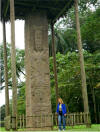  Just over an hour's
drive from the Rio Dulce is Quiriguá,
another Mayan archaeological site set in a beautiful tropical park
atmosphere. While Tikal is known for its sheer grandeur, and Copán
is known for its well preserved carvings, inscriptions and tunnels, Quiriguá
is known for its very tall and intricately carved stelae - the largest known
in the Mayan world. The largest measures 36 feet (26 ft. above ground
and about 10 ft. below ground) and weighs approximately
130,000 pounds. Just over an hour's
drive from the Rio Dulce is Quiriguá,
another Mayan archaeological site set in a beautiful tropical park
atmosphere. While Tikal is known for its sheer grandeur, and Copán
is known for its well preserved carvings, inscriptions and tunnels, Quiriguá
is known for its very tall and intricately carved stelae - the largest known
in the Mayan world. The largest measures 36 feet (26 ft. above ground
and about 10 ft. below ground) and weighs approximately
130,000 pounds.
The write-up on this
trip has been included on the page that also has the write-ups
on the Maya ruins of Tikal and Copán.
Click here to go to the Quiriguá
Maya Ruins write-up, slide show and trip recommendations (located on
Pictures/Journal page 20).
[ Top of page ]
|
| |
|
COPAN
MAYA RUINS '08
  Deborah had been to
Copán in 2006 and wanted to get Steve there before we left the river for
good. So a group of six cruisers went by private van for 3 days/2
nights (Steve liked it so much he wished we could have stayed another night
or two). The town of Copán Ruinas reminds us of a mini-Antigua, with a good selection of
nice places to stay and restaurants. The main ruins, called just
Copán, are a short tuk-tuk ride Deborah had been to
Copán in 2006 and wanted to get Steve there before we left the river for
good. So a group of six cruisers went by private van for 3 days/2
nights (Steve liked it so much he wished we could have stayed another night
or two). The town of Copán Ruinas reminds us of a mini-Antigua, with a good selection of
nice places to stay and restaurants. The main ruins, called just
Copán, are a short tuk-tuk ride
  away and we had a away and we had a  good English-speaking guide take us around
the ruins and tunnels. We enjoyed the local museum in town and the
big, good English-speaking guide take us around
the ruins and tunnels. We enjoyed the local museum in town and the
big,  very
nicely done museum (stateside
quality) at the archaeological site.
So as not to repeat
things here, please go to the original write-up and
slide show very
nicely done museum (stateside
quality) at the archaeological site.
So as not to repeat
things here, please go to the original write-up and
slide show of Deborah's first trip here in 2006
(and recently added trip recommendations),
Copán Ruins 2006 write-up and
slide show, and 2008 trip recommendations. of Deborah's first trip here in 2006
(and recently added trip recommendations),
Copán Ruins 2006 write-up and
slide show, and 2008 trip recommendations.
On this 2008 trip, however, we saw and
did things that were new from the original trip and are highlighted below.
| |
|
LAS SEPULTURAS RUINS |
|
 |
 |
A couple of mile
walk from the main ruins are the excavations of Las Sepulturas, most
likely a large residential complex for Copán's elite families. A
local caretaker became our unofficial guide. Using Spanglish we
were able to understand the layout and what was what (as there are no
signs). There were several different "neighborhoods". Each
neighborhood had several houses surrounding what was probably a large
garden area. There seems to be one house that is larger than the
others, where the head guy lived. Our guide told us that the head
guy had many "concubines", as he put it, that lived there. The
beds consisted of stone platforms about the size of a double bed.
I'm sure they padded it with something. |
|
 |
 |
Another
neighborhood appeared much larger with bigger structures than the others.
We were told this is where the really important people lived.
Here, we saw the Palace of the Officials which had outer walls carved
with large figures. Inside is a very long, beautifully carved,
stone hieroglyphic bench. Another building was the "hospital".
In it was a stone bed, the head of it which was an (stone) incline so
the patient could sit up comfortably. A room next door was where
medicinal herbs, animals and whatever were kept and used. |
|
 |
 |
|
 |
In front of the
main house in each neighborhood, there was a tomb deep in the ground.
This is where the nobility was buried. From the picture, you can
see a side chamber (actually there were several) that housed jade, bones
and other valuables for the dead. (The rulers of Copán were buried
under the pyramids and temples.) |
|
 |
A young
ceiba tree - its big thorns protect it. As it matures, the thorns
get smaller and eventually disappear. The ceiba tree was the "tree
of life" for the Mayas. |
|
ON THE TOWN |
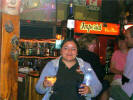 |
We enjoyed
several good meals. Here at Carnitas Nia Lola, the waitresses
serve bottles of wine, and hot queso (over flame) 'n' chips on their
heads. Saw no casualties. Their specialty is grilled meats
and chicken - and it was excellent. |
MACAW MOUNTAIN BIRD PARK
 |
|


 |


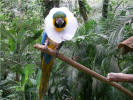 |
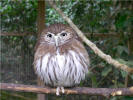

 |
Macaw Mountain, just a 10 minute
tuk-tuk ride from town, is a bird sanctuary and nature reserve for
dozens of rescued and donated parrots, macaws and toucans. It is
set in a river-side, heavily forested park. All birds are
carefully maintained and are able to roam freely in this environment.
In addition, guests are able to hold them.
They also have a very large aviary
cage for those birds that are undergoing de-stressing, and there were a
few.
The pictured macaw
with the white collar, along with
a macaw that Deborah held, belonged to a fellow cruiser on the Rio Dulce. She
no longer could take care of them on her boat so she donated them to the
reserve. The white collar is to keep it from pulling its feathers
out. Our guide said both of her birds were doing very well.
Shown, Steve
bravely inching his way towards this toucan - this is as close as Steve would get to
holding a bird. |
|
Macaw tidbits:
They can live 100 years in captivity and exert 700 pounds of beak
pressure. |
|
 |
 |
This property is also a small coffee
plantation where they grow, harvest, roast and ground their own Coffee
Miramundo. A separate cafe gave us a chance to sample their coffee
and cappuccino - yum! |
|
|
|
|
[ Top of page ] |
| |
|
MISCELLANEOUS
 GUATEMALA,
early 2008: Before leaving the Rio Dulce, Deborah
along with several other cruisers, took a field trip to Lagunita (aka Laguna
Salvador), a nearby village down the Rio Dulce. (Steve stayed home to
do some boat projects - seems he gets more done when Deborah's not there to
supervise. Hmmm.) The impetus behind the trip was a former art
teacher now turned cruiser, who had lots of art supplies onboard, ideas
and the determination to give art lessons to these
children. Long story short, we had a tour of their village (other
cruisers were living in the village attempting to show them how to properly
grow, cultivate, rotate crops, but the frustration factor was high, as these
people only live day to day GUATEMALA,
early 2008: Before leaving the Rio Dulce, Deborah
along with several other cruisers, took a field trip to Lagunita (aka Laguna
Salvador), a nearby village down the Rio Dulce. (Steve stayed home to
do some boat projects - seems he gets more done when Deborah's not there to
supervise. Hmmm.) The impetus behind the trip was a former art
teacher now turned cruiser, who had lots of art supplies onboard, ideas
and the determination to give art lessons to these
children. Long story short, we had a tour of their village (other
cruisers were living in the village attempting to show them how to properly
grow, cultivate, rotate crops, but the frustration factor was high, as these
people only live day to day
 and
cannot understand planning for the future).
Anyway, the kids sang us songs (in both their native tongue Quechi and
Spanish - some even know a little English as a third language) and they had
artfully made thank you cards for us. Art classes took the form of
making t-shirts using leaves the kids picked from their jungle and acrylic
paints to "imprint" the designs; and a separate session painting. A
break in the afternoon and some of us took a trip through the canals and
lagoons in cayucos - the usual means of travel on the river for the
indigenous. Notice the low freeboard! and
cannot understand planning for the future).
Anyway, the kids sang us songs (in both their native tongue Quechi and
Spanish - some even know a little English as a third language) and they had
artfully made thank you cards for us. Art classes took the form of
making t-shirts using leaves the kids picked from their jungle and acrylic
paints to "imprint" the designs; and a separate session painting. A
break in the afternoon and some of us took a trip through the canals and
lagoons in cayucos - the usual means of travel on the river for the
indigenous. Notice the low freeboard!
  After
a year and a half of living in Guatemala, and really enjoying it, we are sad
to leave but have so many great memories to take with us. As we
prepare to leave Monkey Bay Marina, the howler monkeys are making frequent
visits (though rarely did I have my camera handy) and so are the orchids. After
a year and a half of living in Guatemala, and really enjoying it, we are sad
to leave but have so many great memories to take with us. As we
prepare to leave Monkey Bay Marina, the howler monkeys are making frequent
visits (though rarely did I have my camera handy) and so are the orchids.
We cross the shallow bar at Livingston
to leave the Rio Dulce without incident and head for Belize. A few
days after leaving, we hear that there has been an uprising on the Rio Dulce
of the indigenous: Seems that one of the village's chief had been
arrested in Guatemala City (don't know why) and the locals wanted him
released. They kidnapped several policemen from the police station,
took them hostage on their own police boat (and then went to refuel), then
headed down the river. It was short lived. Within the week,
however, 2 more incidents had occurred: They stormed official offices in
Livingston, and another time took 2 Belgian tourists hostage. All were
short lived with no real harm done. Part of this is probably related
to the new president, whose campaign platform was to crack down on violence,
etc. (See box below And The Winner Is . . .)
Halloween on the Rio Dulce:
Can you guess who we are?
|
AND THE
WINNER IS . . .
The Guatemala
presidential election took place in the fall. Alvaro Colon,
leftist, won by 5%, being supported by the rural population (outside
Guatemala City and Antigua). He ran on the platform of
security and violence issues. Although over a dozen candidates
vied for the office, it's really a 2-party system. The
elections were carried out in a calm and civilized manner.
After the election, we heard that President Bush called Colon and
informed him that if he should get cozy with Venezuela's Hugo
Chavez, then the U.S. would have to cut off all its aid to
Guatemala.
The other
winner was Guatemalan Carlos Penas as the Latin American Idol.
We were in Guatemala City during the finals and at the moment he was
announced as winner the Zona Viva (the nice, safe area we stay in)
broke out in a loud hullabaloo with big firework displays.
|
|
|
Continued
. . . |
[ Back ] [ Home ] [ Up ] [ Next ] [ Top of page ]
|
![]()